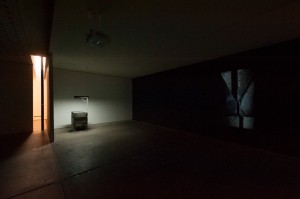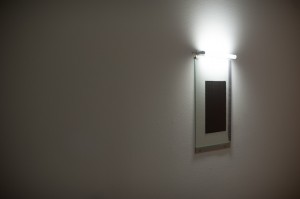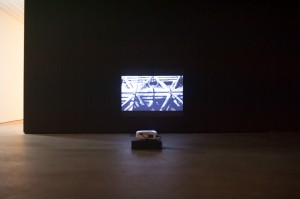The clock and the rock: Aesthetic of the emblematic
4:17 pm. What happens to time if we fold it in half like a piece of paper, and then unfold it? Are the wrinkles at the end or the beginning? This is a poorly recalled line from one of the 6000 films sampled in Christian Marclay’s epic video work, The clock, currently on view at the MCA, Sydney. The clock is a filmic ensemble of references to (real) time: it is a marking of time. The work is a pummelling of continuity and an unrelenting tide of the tessellated, criss-crossed—edits operating as objects?—as opposed to sequential action and event. A comparison to The clock assisted my (difficult) rethinking of Nicholas Mangan’s Some kinds of duration.
A concrete photocopier is dull-ly and appropriately lit by a fluoro light within the gallery space. Two projections, one silent, are in constant motion. One in particular is lusciously rubbly. These three works, which comprise the guts of Some kinds of duration, appear to this viewer to work together to a clean brevity. I am reminded by a friend that the work was noisy and dirty, but this isn’t how I reflect on my walk around it.
How to feel for manufacture? Like Marclay, Mangan’s recycling and imbricating of fragments speak loudly of process and construction. This comparison feels particularly useful in the search to locate Duration’s narrative charge. Writer Zadie Smith suggests that The clock is a subjective ‘factual response to the fantasies of film’. Duration’s components operate as fantastical responses to the facts of time and place. Searching for a narrative kick, Duration appears attenuated while, in comparison, The clock pivots on brevity.
Each element of Duration reflects on archaeology—the central axis on which the exhibition seems to scenically spin. Archaeology: the excavation, systematising, and the piecing together of remnants to reveal the various narratives connected with quotidian human relations. Some of these things are whole and some of these things are fragmentary. And like Marclay’s work, there is real-time and staged-time pushed hard up against each other. Some kinds of duration positions its collection of historical references adequately enough for a momentum to build. But, perhaps to the viewer’s detriment, the fantastical is slimmed-down and the work retreats in the repeat.
Nicholas Mangan, Some kinds of duration, Centre for Contemporary Photography, Melbourne, 10 February — 1 April 2012.


